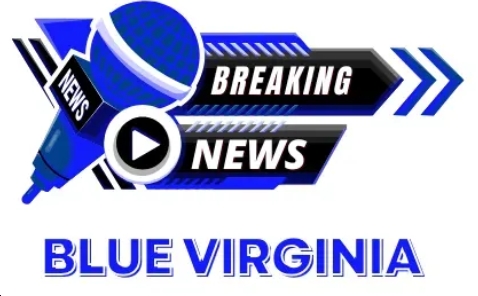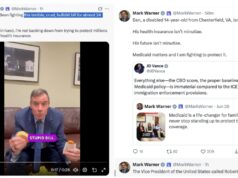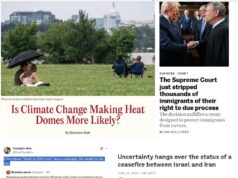by Kellen Squire
I’m not sure when it was, exactly. After I’d lost count of the number of people I’ve had to watch die who, prior to getting COVID, had been caught up in the insanely politicized response to this pandemic. The number who had fallen victim to a combination of governmental incompetence and a billion dollar campaign to prevent our country’s recovery from COVID. Who had said some variation of “I don’t trust the science” of the vaccine, that it was a “pharmaceutical scam”, that it was “created from aborted babies”, etc.
I’d watch them linger in the ICU for weeks (or months), praying each day for any sign of improvement, remembering vividly when they came into the ER. Panicked. Wanting us to do everything we could, because everything at home was failing. The homeopathic stuff they’d heard about, the treatments that media talking heads (including those who pushed healthcare workers out of line to get their COVID vaccination) touted, the Facebook remedies being shared in anti-vax circles? None of it worked.
There’s no joy in “I told you so” here. Not one iota of schadenfreude. I get cold, steely disgust when I read those kinds of exhortations. Oh, sure, I’ve rolled my eyes at people who come to us with a “COVID man cold” (certain they’re nearing the end) who, once we do our work to make them feel better, are telling everyone two weeks later “Pfft, I had COVID and it was no big deal! I shotgunned a beer and did a triathlon on my worst day!”
But at least they’re home. They’re with their family. So I just count it as a win a move on, because of how precious few wins there are in any of this.
********************
I’ve only seen two or three of the really critical cases I’ve personally worked with ever go home – only one who left under their own power. The rest of them linger for days, weeks. Months. But always the same end. Still, I’d check and see how they were doing before every shift. Ask their nurses if there was any sign of improvement whatsoever, even though I learned to temper my hope. Every improvement I saw invariably seemed to be fleeting – as if Fate were taunting us all.
My rage still burns at how unnecessary this all was. These people were led astray by people who didn’t give one single damn about them. Joe Rogan isn’t going to host them a Fourth of July cookout. Tucker Carlson won’t be taking pictures at graduation. Laura Ingraham isn’t helping open presents on Christmas morning.
Knowing how many of those people would be home with their families had they been vaccinated, I resolved to figure out how, as a country, we could go from convincing 96%(!) of Americans to keep up to date with critical, life-saving immunizations, to a mere 63.9% currently fully vaccinated for COVID. What I discovered surprised me – though it probably shouldn’t have. It seems the more things change… the more they stay the same.
I found debates from sixty years ago about boosters; about how many shots one needed for sufficient immunity. I read about bad actors arguing against some (or all) vaccinations. About kids forced to do “distance learning” because of surges in infection rates. Arguments that the disease they were trying to fight had a “99.5%” survival rate. All of those were hallmarks of the discussions and arguments surrounding vaccinations in the mid-20th century, yet wouldn’t have been out of place at almost any time in the past two years.
Dr. David Bodian was one of the leading scientists behind the effort to fight polio. It was his research that demonstrated there were only three strains of polio, and that it was transmitted orally, via the digestive tract and into the bloodstream and nerves, instead of being airborne (as had been long assumed).
In 1954, as America began to prepare for a nationwide effort to vaccinate 1.8 million school children in a now-standard double-blind study (where neither the patient nor researcher knows if they received a vaccine or placebo), Dr. Bodian discussed the findings of the preliminary polio trials, noting that a single shot may not confer sufficient coverage for lifelong protection from symptomatic infection. “We will not see more details for some time,” he wrote, but “eventually such reinfection may take place.” The question at the time was whether further “boosters” would be needed, or if a reinfection – if it occurred – would be sufficient protection. “It is probable,” Bodian theorized, “that such a reinfection will lead to a rise in antibody level or the so-called ‘booster’ effect, serving to reinforce the original state of immunity.”
And, yes, just as Dr. Bodian presumed, “breakthrough” infections occurred because of how “hot” an environment the people at the time lived in. Polio was endemic, incredibly infectious, and everywhere. It took seven years of research and data for the current four-dose polio regimen to finally become the standard. And it worked – the last case of wild polio in the United States occurred in 1979.
I could go on and on about this. Measles, hepatitis, HiB, tetanus- basically, every vaccination we currently take for granted went through similar cycles during their introduction. But if these are all things we’ve been through before, why are things so bad this time around?
I had a few hypotheses. One, while there were robust “antivax” organizations in the past, both here and abroad, none were as politically weaponized as they are today, nor led by folks who, themselves, rushed to get vaccinated as quickly as possible.
Two, that generation seems to have been much tougher than we are today. After all, the folks in 1954 had been through the Great Depression; had come back (or knew people who didn’t) from fighting fascism and totalitarianism in places like Normandy and Iwo Jima. They would have been overwhelmed with joy if the only sacrifice being asked of them was to occasionally wear a surgical mask.
Jackie French Lonergan, one of the very first school children vaccinated for polio in 1954, said as much to the Washington Post. “We were very patriotic then,” she told them. “The war was over and the country was booming. It was a very optimistic time… It’s really hard to understand what is happening today.”
Which notes – last but not least – that those folks knew exactly what “no vaccines” looked like. There was no question about it. They, and every generation that had preceded them, had witnessed the consequences wrought unremitted by these diseases… consequences so far removed from us today that we simply take for granted their absence in our lives. Remember, up to 70% of polio infections were asymptomatic, and the worst symptoms – chronic fatigue, breathing problems, and paralysis – sometimes took thirty or forty years to show up.
I think those hypotheses are all still valid to varying extents. But there was one big difference I discovered between then and now that, in hindsight, should have been incredibly obvious- and played a huge role in getting damn near every schoolchild in the country vaccinated for polio.
Family doctors.
In preparation for enrolling millions of first, second, and third graders nationally in the rollout of the Salk polio vaccine, a study was conducted in rural, suburban, and urban Virginia in 1954. While we now know Fairfax County, Virginia as the bustling heart of urban northern Virginia, in 1954 it ranged from very rural (as in, “no electricity or indoor plumbing” rural) to the outskirts of the DC Metroplex which, while not as urbanized as it is now, was certainly considered so by 1950s standards.
There are parallels to today. The more educated and affluent a child’s parents were, the more likely they were to agree to have their child participate in the polio study. The bigger a parents’ social circles were – and what those social circles thought about vaccination – played a large role in their ultimate decision on the matter. And having seen other people suffer the effects of polio made them far more likely to want to participate in the study.
But the researchers also made clear that one of the biggest factors in whether or not someone allowed their child to participate in the study was access to a family doctor who sat down with them and addressed their concerns. That variable skewed across all other controls for education, income, experience – everything. If a parent had a family doctor with whom to discuss their concerns with, they were dramatically more likely to agree to participate in the polio study than not.
My kids’ primary care physician is one of these old-time docs. He’s been practicing in rural Free Union, Virginia since the Carter Administration; he not only delivered both of my sons, he delivered my wife. If he stays in practice much longer, he could easily be delivering a third generation of children. Besides obstetrics and pediatrics, he moonlit as an ER doc, and took endocrinology training to make sure he could help manage his patients’ diabetic conditions effectively. He is an institution in our part of rural Virginia, doing more to keep the folks there healthy – and out of the hospital – than most people realize.
And he’s not an anomaly. The primary care providers I see, day in and day out, in our community wear so many “hats” that I couldn’t begin to keep count of them all. They’re the silent heroes in all of this – if not for them holding the line and going so far above and beyond what they are expected (and paid!) to do, the whole house of cards would’ve fallen down already.
For years and years now, we’ve heard warnings about the “looming” primary care crisis in this country – I put “looming” in quotes because, much like when people warn us that “the healthcare system could collapse”, that’s not a hypothetical- it’s already happened.
Even before COVID, the shortage of primary care doctors in our country was costing American lives. We’ve spent decades systematically undermining primary care. Physicians are saddled with crippling medical school debt. Advanced practice clinicians (such as nurse practitioners and physician’s assistants) are systematically kneecapped in their ability to work in primary care. And aside from innumerable structural barriers, we actively stigmatize providers who want to seek roles in primary care fields. The COVID-19 crisis has only supercharged this.
Instead, our healthcare system has been more concerned about profit. They’ve driven physicians out of offices and into hospitals, thanks to unstoppable (and monopolistic) horizontal and vertical consolidation and “just in time” efficiency models for everything from medical supplies to critical clinical staff. They’ve incentivized providers to seek more and more specialized care, and sunk the vast majority of our infrastructure into acute care instead of primary care. Not to belittle the leaps and bounds medical science has taken; some things that even ten or twenty years ago would’ve been a death sentence are now considered just above a nuisance. But these things were never intended to replace primary care; merely supplement it.
But that’s not where we’ve ended up. Instead, we’re reaping the dividends of our backwards system. The United States has one of the lowest rates of COVID vaccination rates amongst industrialized countries, to add to the list of metrics showing just how horrible our country is at managing health and healthcare.
Bad actors with billion dollar campaigns behind them; people who’ve been insulated from the horrors of the past by several generations; an unprecedented and unpatriotic attempt to openly kill Americans. All of these things have absolutely contributed to where we find ourselves today – but all could have been at least ameliorated by ensuring every American had access to a trusted healthcare provider with whom to discuss their health concerns with.
We will not be able to manage the next generation of people seeking healthcare – much less the next crisis – in this country without addressing this problem immediately. Every Virginian deserves to have a primary care provider; someone who can help them manage their health and wellbeing, address crises before they worsen, make it unnecessary for people to come to the ER or wait for months to see a specialist.
The Commonwealth (literally!) cannot afford to hedge on this any longer, and if Washington continues to refuse to act, then Richmond must instead.


 Sign up for the Blue Virginia breaking news newsletter
Sign up for the Blue Virginia breaking news newsletter






![“Attorney General [Jason Miyares] is a coward who refuses to defend our state’s laws [against so-called ‘conversion therapy’] that demonstrably prevent suicide”; “Glenn Youngkin is simply despicable”](https://bluevirginia.us/wp-content/uploads/2025/07/youngkindespicable-100x75.jpg)

